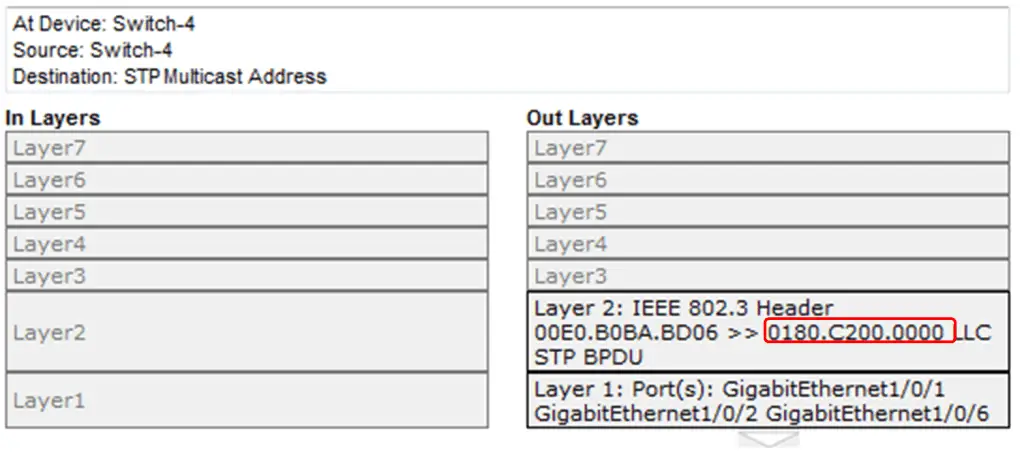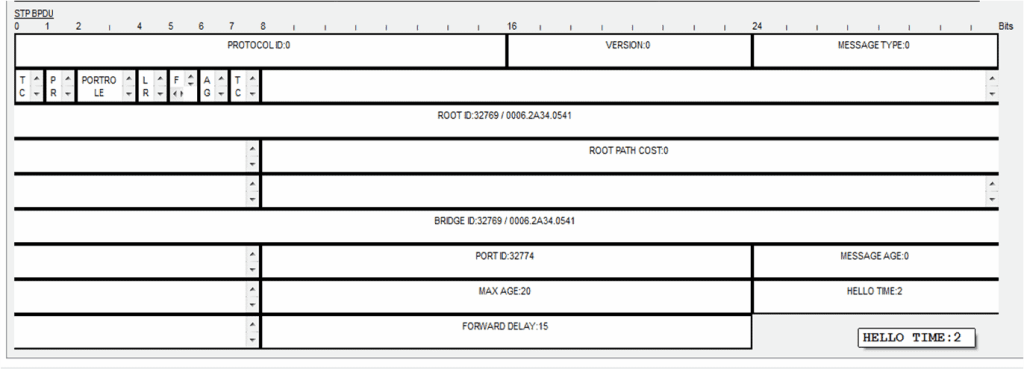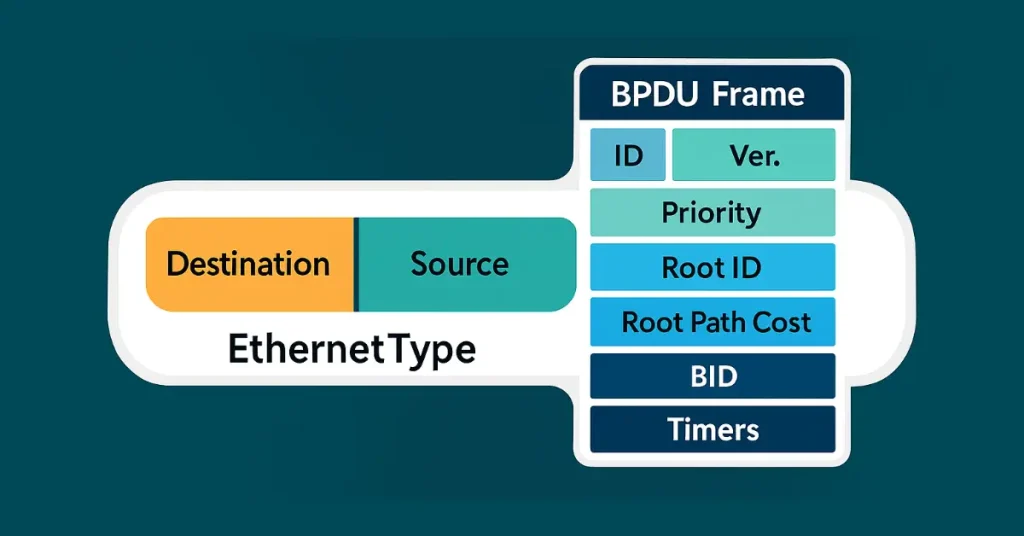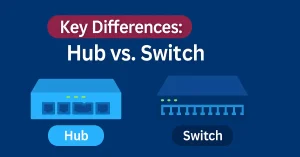In CCNA labs, spotting a BPDU storm can crash your network—understanding the frame format is your first line of defense.. The spanning tree algorithm exchanges the Bridge Protocol Data Unit (BPDU) to elect the Root Bridge. It is a frame containing 12 different fields with different information. The information in the BPDU is used to determine the root bridge and the paths to the root bridge. The figure below illustrates the Bridge Protocol Data Unit (BPDU) frame fields.

The first four fields recognize the protocol, version, message type, and status flags. The following four fields identify the root bridge and the path’s cost to the root bridge. The last four fields decide the timer values for Bridge Protocol Data Unit (BPDU) messages. When sent across the network, the Bridge Protocol Data Unit (BPDU) frame is encapsulated in an 802.3 Ethernet frame.
The 802.3 Ethernet headers contain the source and destination addresses of the Bridge Protocol Data Unit (BPDU) frame. The figure below illustrates an STP packet encapsulated into 802.3 headers. This frame has a destination MAC address of 0180:C200:0000.
This is a multicast address for the spanning tree group. When a frame is addressed with this MAC address, each switch in the domain configured for the spanning tree accepts and reads the information from the frame. All other devices on the network ignore the frame. The following table illustrates all fields of the BPDU Frame.
| Field | Size (Bytes) | Value/Example | Description & CCNA/CCNP Relevance |
|---|---|---|---|
| Protocol ID | 2 | 0x0000 | Identifies STP family (always 0 for 802.1D) |
| Version | 1 | 0 (802.1D), 2 (RSTP), 3 (MSTP) | Legacy STP = 0; important when migrating to RSTP/MSTP |
| BPDU Type | 1 | 0x00 = Config, 0x80 = TCN | Determines Configuration BPDU vs Topology Change Notification |
| Flags | 1 | Bit 0 = TCA, Bit 7 = TC | Topology Change & Acknowledgment flags |
| Root Identifier | 8 | Priority + MAC (e.g., 32768:000c.29ab.cdef) | Lowest value becomes Root Bridge – key election criteria |
| Root Path Cost | 4 | Cumulative cost (e.g., 19 for 1 Gbps) | Increment per link (modern Cisco: 10G=4, 1G=19, 100M=100) |
| Bridge Identifier | 8 | Priority + MAC of sender | Used when Root IDs are equal – tie-breaker |
| Port Identifier | 2 | Priority.Port number (e.g., 128.5) | Identifies sending port; lower = better |
| Message Age | 2 | Seconds since Root generated BPDU | Starts at 0, increments per hop |
| Max Age | 2 | Default 20 seconds | Time before BPDU is discarded – prevents infinite loops |
| Hello Time | 2 | Default 2 seconds | Interval between Configuration BPDUs |
| Forward Delay | 2 | Default 15 seconds | Listening + Learning combined delay (30 sec total) |
Pro Tip: Root Bridge ID = 4-byte Priority (default 32768) + 6-byte MAC. Lower priority wins; if equal, lower MAC wins.

The figure below illustrates the Bridge Protocol Data Unit (BPDU) detail inside the 802.3 headers. The root ID and the BID is the same in the captured Bridge Protocol Data Unit (BPDU) frame. This indicates that the frame was captured from a root bridge. All the timers are set to the default values.

802.1D Bridge Protocol Data Unit (BPDU) Propagation and Process
When a switch booted, it sends a Bridge Protocol Data Unit (BPDU) to assume it is a root bridge for the spanning-tree protocol. The BPDU frames contain the BID of the local switch as the root ID, as you can see in the above image.
The default BPDU sending time is two seconds, so the switch sends a BPDU after every two seconds. The default value of the Hello timer in the BPDU frame is set to two seconds. Each switch maintains local information about its self-BID, root ID, and the path cost to the root.
When nearby switches receive a Bridge Protocol Data Unit (BPDU) frame containing the root ID, the root ID from the BPDU frame is compared with the local root ID. If the root ID in the BPDU frame is lower than the local root ID of that switch, it updates the local root ID and the ID in its Bridge Protocol Data Unit (BPDU) messages.
These messages show the new root bridge on the network. The distance to the root bridge is also updated by increasing the path cost of the incoming interface. For example, if the Bridge Protocol Data Unit (BPDU) frame is received on an Ethernet port, the path cost would increment by 1100. If the root ID of the local switch is lower than the root ID received in the Bridge Protocol Data Unit (BPDU) frame, the Bridge Protocol Data Unit (BPDU) frame is discarded.
When the root ID is updated to identify a new root bridge, all consequent Bridge Protocol Data Unit (BPDU) frames sent from that switch contain the new root ID, including the path cost. So, all other nearby switches can always see the lowest root ID identified.
As the BPDU frames receive and pass between other adjacent switches, the path cost is constantly increased to indicate the total path cost to the root bridge. Each switch chooses the best path in the spanning tree to use its path costs to reach its root bridge.
FAQs
What is a Bridge Protocol Data Unit (BPDU)?
A BPDU is a data message exchange across switches within an extended local area network. BPDUs contain information on ports, addresses, priorities, and costs and are essential for enabling the Spanning Tree Protocol (STP) to maintain a loop-free network topology.
What role do BPDUs play in network stability?
BPDUs help detect loops and ensure a loop-free network configuration. They allow switches to share information about network topology and make decisions about preventing loops and optimizing paths.
How often are BPDUs sent in a network?
BPDUs are typically sent at regular intervals by network switches. The standard interval is every 2 seconds. This frequency ensures continuous monitoring and maintenance of the network topology.
What are the different types of BPDUs?
There are two main types of BPDUs: Configuration BPDUs and Topology Change Notification (TCN) BPDUs. Configuration BPDUs are used to maintain the Spanning Tree Protocol (STP), while TCN BPDUs are used to notify changes in the network topology.
How do BPDUs prevent network loops?
BPDUs help identify redundant paths in a network. The Spanning Tree Protocol (STP) uses BPDU information to disable the redundant paths, ensuring only one active path between any network devices, thus preventing loops.
What is the BPDU Guard, and why is it important?
BPDU Guard is a feature that can be enabled on network ports to prevent BPDUs from being received on those ports. This feature is essential for protecting the network from loops caused by misconfigured devices or malicious attacks.
How can BPDUs impact VLAN configurations?
BPDUs are crucial for maintaining network topology within VLANs. They help ensure that each VLAN maintains a loop-free topology and traffic efficiently routed within the network.
What is the difference between BPDU filtering and BPDU guard?
BPDU filtering prevents BPDUs from being sent or received on specified ports, while the BPDU guard shuts down a port if it receives a BPDU, preventing the port from causing potential network loops.
How do you configure BPDUs on a network switch?
Configuring BPDUs on a network switch typically involves accessing the switch’s management interface and enabling or adjusting BPDU-related settings, such as allowing BPDU Guard or configuring BPDU intervals.
Why is understanding BPDU types and their functions important for network administrators?
Understanding BPDU types and their functions is crucial for network administrators to ensure a stable and efficient network. Proper BPDU management helps prevent network issues, optimize traffic flow, and maintain overall network health.
Conclusion
Mastering the BPDU frame format and protection mechanisms is non-negotiable for passing CCNA/CCNP and for designing stable enterprise networks. Practice capturing BPDUs in Packet Tracer or GNS3, enable BPDU Guard in your labs, and you’ll never fear STP questions again.





